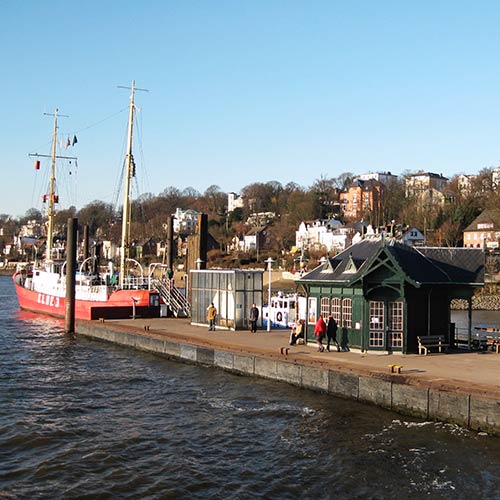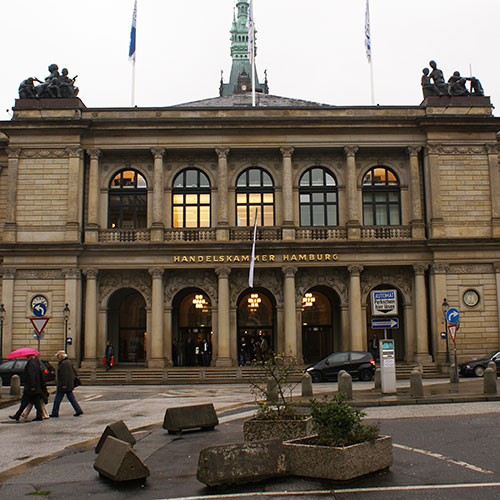History of Hamburg

The origins of Hamburg: "Free and Hanseatic City of Hamburg / Freie und Hansestadt Hamburg" is the full name of the second largest city in Germany in terms of inhabitants. A name which suits it perfectly and which sums up with excellence the particularities of its history which we summarize on this page. Photo: © SHMH / Sinje Hasheider
Although archaeology attests to the passage of hunters and occupation in the Elbe region from the Stone Age, Slavic and Celtic, the History of Hamburg only began in the 9th century. The idea that the Romans occupied the region remains a legend, in the absence of any evidence to the contrary.
Hammaburg - Charlemagne and the Christianization of the North : The Emperor of the Franks Charlemagne succeeds in controlling this Saxon region of Elba with the support of the Slavic tribe of the Obodrites. In the year 810, Charlemagne had a baptismal church built between the river Bille and Alster. The mission of the priest according to the name of Heridag was the Christianisation of the polytheistic regions of Schleswig-Holstein and Scandinavia. To secure this first wooden church, a small fort (Burg) was built on the site of a modest Saxon village called Hamm, which resulted in the first mention of the name Hammaburg in the year 832. Today it is assumed that the meaning of this name has its origins in the old German "Hamme" and refers to a moraine area naturally protected by swamps. Because of the important religious mission, Hammaburg soon became an archbishopric with "Ansgar von Bremen" as its bishop. However, due to numerous attacks by the former allies, the Obodrites (915-983-1066-1072), the seat of the bishopric Hamburg-Bremen was definitively established in Bremen, giving Hamburg the advantage of greater independence. In the 11th century, Hamburg experienced a great development both in terms of urban planning (new churches, monasteries, palaces and a defensive wall) and economically because of the city's central position for Christianisation on the North and Baltic Seas, thus began the first commercial alliances which would soon lead to the Hanseatic League. In 1060 Hamburg was divided into two parts, one headed by the Duchy of Billunger and the other by the Archbishopric.
Hamburg at the time of Schauenburg : The death of the last member of the Billunger line made Adolphe I. von Schauenburg, Duke of the city of Hamburg. During the 12th century the main events were the colonisation of several islands in the Elbe, the formation of the artificial lake of the Alster for the supply of mills, the creation of the Neustadt (new town) for merchants and above all, in 1189, Emperor Frederick I. Barbarossa is said to have granted a Free City Charter to Hamburg giving all the rights and freedom for Hamburg to develop as an independent city on land and sea. This charter was used for several centuries by Hamburg to defend its rights against other powers such as the Danes. However, in the absence of the document (lost or never written), a copy of the charter was drawn up in 1265. In the 13th century, several wars and occupation by the Danes led to some changes, including the unification of the two cities with a town hall, council and court under the authority of Duke Adolf IV. (1228), but the latter was only marginally involved in the management of the town and in 1239 he chose monastic life. Also in 1240 a fortification was built. Today, place names such as Steintor, Millerntor and Alstertor mark the location of its gates.
HHamburg and the Hanseatic League - Between the 13th and 17th centuries : With the foundation of Bergen in Norway in 1070 and several cities such as Lübeck, Rostock, Wismar, Stralsund, Stettin and Danzig, the first bourgeois commercial alliances between these North Sea and Baltic cities began. The Teutonic Hanseatic League was founded in 1241 between Hamburg and Lübeck before rapidly expanding to the above-mentioned cities and other trading posts such as London (1266), Flanders (1252) and France (1294). Initially the alliance was a Hanseatic League of merchants before becoming a Hanseatic League of cities in 1280, giving its cities even more power through the sea blockades that could be set up against kings who denied civil rights to Hanseatic merchants. The first Hanse assembly (Hansetag) was held in Lübeck in 1356. The closure of the trading post in Novgorod in 1494 and competition between English and Dutch merchants marked the decline of the Hanseatic League, which would not have the same form after the Treaties of Westphalia in 1648. The last Hanseatic assembly took place in 1669. However, Hamburg, Lübeck and Bremen continued the tradition of this alliance. During the years of Hanseatic supremacy, Hamburg used its fortune to build new churches or to rebuild buildings worthy of the city's reputation. Even today, Hamburg (and other German cities) still shows its status as a Hanseatic city in its name and in the registration plates with HH for Hansestadt Hamburg. Also associated with the Hanseatic period, the pirates! Many took advantage of the maritime traffic to establish themselves as bandits. Between the 13th and 16th centuries, the Hanseatic cities had to fight these pirates. The last one was Klaus Kniphof (killed in 1525), but the best known was Klaus Störtebeker (1360-1401), nicknamed the "Red Corsair", who is a figure with many legends known to the people of Hamburg.
Hamburg between the 15th and 18th centuries: Beside the Hanseatic history mentioned above, here are now some other important events. After the death of the last count of the von Schauenburg family in 1459, Hamburg had to regularly defend its right to remain free and to keep all its privileges. The nearby town of Altona (today Hamburg) was between 1640 and 1867 a Danish town, the second largest in Denmark. In 1500 Hamburg became part of the imperial territory of Lower Saxony without changing its status and in 1618 Hamburg officially became a free city of the Holy Roman Empire (Freie Reichstadt). The 16th century was marked by the Reformation and the immigration of numerous populations. In 1528, Mayor Johann Wetken invited Martin Luther to send Johannes Bugenhagen to establish the new religion in Hamburg and in 1529 the city became evangelical. Following the counter-reformation in the Spanish Netherlands, a large number of emigrants came to settle in Hamburg and Altona (from 1567). Around 1600, Sephardic Jewish families were also welcomed after their expulsion from Spain and Portugal, the "natio lusitana". During the 17th century, marked by the Thirty Years' War, Hamburg, which did not suffer from the war, benefited greatly financially from trade with Spain and Portugal, which enabled the city to "buy" itself the pursuit of its territorial freedom from its neighbours. Around 1620 Hamburg built a new fortification which divided Lake Alster into two parts. In the 18th century, economic, cultural and demographic development continued, from 30,000 inhabitants in 1700, the population increased to 100,000 in 1787. During these years, the image of an intellectual city became known all over the world; several high schools, academies, the newspaper "Hamburgische Correspondenten" was read all over Europe and trade spread to other continents after the end of the North American War of Independence in 1783.
Modern history of Hamburg from the 18th century : After the French Revolution and to demonstrate its will to remain neutral, from 1804 Hamburg gradually dismantled its fortifications, but this did not prevent Napoleon's army to occupy Hamburg from 1806 to 1814, indeed, Hamburg was crucial for the implementation of the maritime blockade against the United Kingdom. After this French episode, Hamburg very quickly went from a city with medieval infrastructure to a modern city, the industrial boom led to a massive shift from the countryside to the city with its negative social repercussions (poverty, cholera and others). The population grew from 300,000 in 1860 to 1 million in 1914. Discontent led to a strong trade unionist and social democratic tradition in Hamburg, which led to a new constitution in 1860. Also noted in the history of Hamburg was the major fire in 1842 which destroyed 25% of the city. At the political level, from 1867, the regions around Hamburg became Prussian and the city was first part of the German Confederation, then a state of the Confederation of North Germany and finally a federal state of the German Empire from 1871. Naturally, Hamburg lost some of its former independence, but on the other hand it benefited greatly from it as the largest cargo port in the Empire and as the gateway to the Empire for merchant and military ships leaving for the German colonies.
At the end of the Empire, the First World War was very damaging for Hamburg because of the closure of the goods traffic, unemployment, poverty and social instability that marked those years. While the port of Hamburg was for a long time the gateway for refugees coming to settle in Hamburg, between 1815 and 1934, 10% of the 50 million Europeans who left for the New World from this port.
With the Weimar Republic, the Free State and Hanseatic City of Hamburg (official name since 1819) had its first 100% democratic elections on 16 March 1919. Until 1931, Hamburg enjoyed good political, social and economic stability. Since 27 September 1931 and a vote resulting in 26.3% for the NSDAP and 27.8% for the SPD no lasting coalition could be formed. With the seizure of power in January 1933 by the National Socialists, Hamburg followed Germany's destiny, with the death of half of Hamburg's Jews (19,400 in 1933) and the execution of 55,000 prisoners in the Neuengamme concentration camp (Hamburg), not counting all the other victims. The inhabitants themselves experienced the bombing in July/August 1943 (Operation Gomorrha) with the death of 40-50,000 people, 35% of the buildings were completely destroyed and only 20% of the dwellings survived unharmed.
After the war, the city under British control quickly recovered and became an important location for all the Bundesländer (federal states) in northern Germany, for example with the headquarters of the NWDR television station. On the night of 16-17 February 1962, 300 Hamburgers were killed in a tidal wave. Helmut Schmidt (SPD, born 1918) was praised for his handling of the crisis and became German Chancellor from 1974 to 1982. Today the city of Hamburg is dominated by the important project of developing the port area (HafenCity / Speicherstadt) into an office, tourist and leisure area with, for example, the Elbe Philharmonic.
To learn more about Hamburg's history and to discover its many monuments and districts, we encourage you to take advantage of the services of our tour guide Denise Faessel, who will introduce you to Hamburg during an exciting guided tour.






















